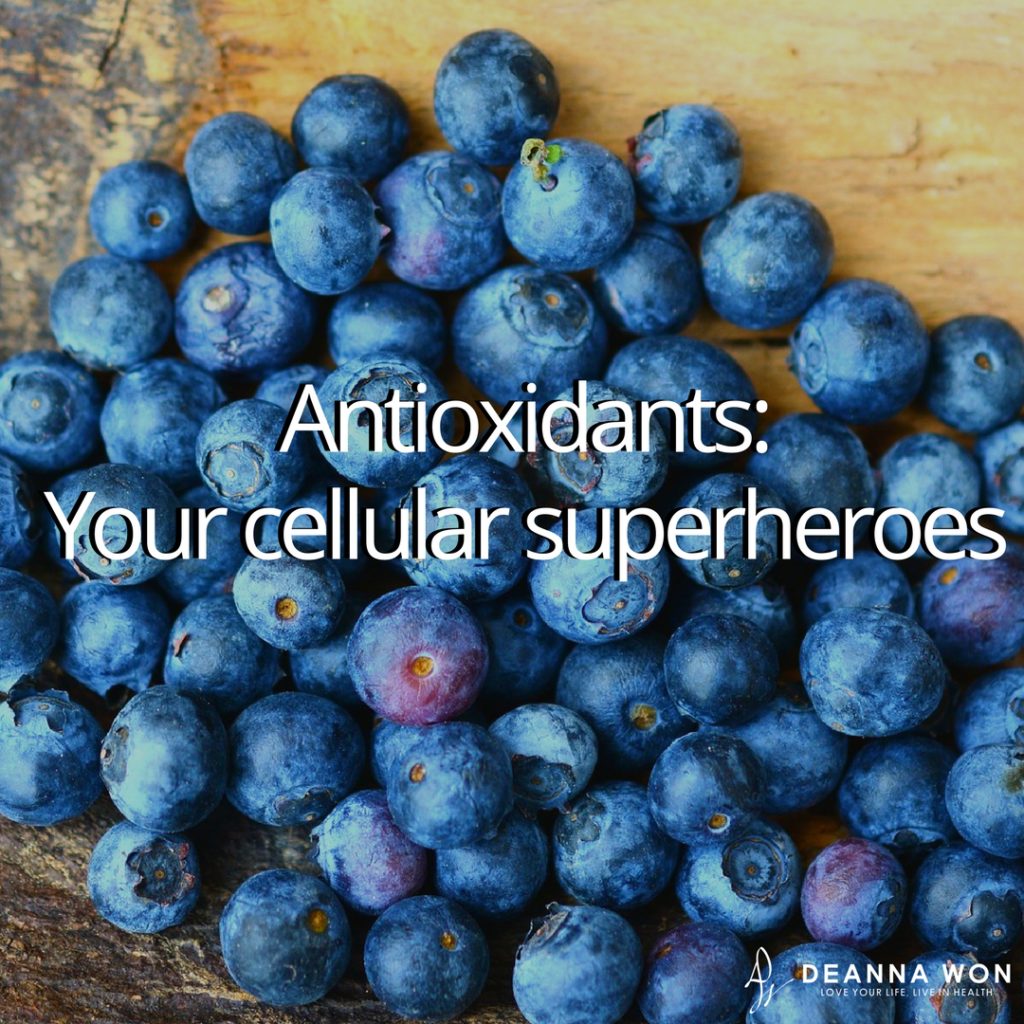Do you ever hear all this talk about incorporating antioxidants into your diet and wonder what it’s all about? What exactly are antioxidants and what role do they play in your health? To gain an understanding into this, we’ll have a delve a bit into some physics and chemistry, but don’t let that deter you.
All matter is made up of tiny particles called atoms. Groups of atoms create molecules. Groups of molecules create tissue. Atoms are comprised of a nucleus, which is at the center and contains positively charged protons and neutrally charged neutrons, along with orbiting, negatively charged electrons. Electrons are typically found in pairs in an atom. However, there are times when an atom, or molecule, loses an electron. When this electron loss occurs, a free radical, defined as an unstable, electrically charged molecule, is formed. Free radicals can react with and damage other molecules, like your DNA.
The production of free radicals occurs naturally in the body when food is metabolized or converted into energy. We can also ingest free radicals, which are prevalent in diets rich in animal fats, preservatives, and soft drinks. Additionally, we breathe them in through polluted air, cigarette smoke, and indoor air where there are appliances running like televisions, refrigerators, and computers, which positively ionize the air (for more information on this, please read my article on Fresh Air and Sunshine—Keys to Vibrant Health.
In taking a closer look at free radicals, there are five types that can be found in the body, four of which are derived from oxygen called Reactive Oxygen Species (ROS) and others are derived from nitrogen, all of which are capable of disrupting or damaging the cells in your body, as well as the structure of DNA, as they are chemically reactive.
Superoxide ion: An oxygen molecule (O) with an extra electron, capable of damaging the mitochondria, DNA, and other molecules.
Hydroxy radical: A very reactive molecule (OH) that has lost an oxygen molecule. This free radical can damage any molecule in close proximity and cannot be eliminated by enzymatic reaction.
Singlet oxygen: A free radical formed by your immune system which can cause oxidation of your LDL cholesterol.
Hydrogen peroxide: Chemically known as H202 Although not technically classified as a free radical, it easily converts to free radicals like OH.
Reactive Nitrogen Species (RNS): This is simply defined as nitric oxide (NO).
High levels of free radicals in the body can cause oxidative stress, a process that can trigger cell damage and cell death. To counter the effects of the production of free radicals, our bodies utilize antioxidants to neutralize the unstable, electrically charged molecules, by replacing the missing electrons. Because oxidative stress occurs when the number of free radicals greatly exceed the number of antioxidants, this imbalance is believed to play a pivotal role in diseases such as cancer, cardiovascular diseases, Alzheimer’s, and Parkinson’s.
Antioxidants are compounds that are found in foods, especially plant-based foods, that counteracts damage to your cells caused by free radicals. These are compounds like Vitamins A, C, and E, resveratrol (found in grape skins), and lycopene (found in tomatoes), just to name a few.
Antioxidant molecules donate their electrons, amazingly, without becoming free radicals themselves. According to Dr. Richard A. Passwater, author of the book The Antioxidants, there are two types of antioxidants – Non-enzymatic antioxidants which work by interrupting free radical chain reactions, and Enzymatic antioxidants, which break down and remove free radicals.
One way to look at the effects of free radicals in the body is by looking at an apple. When you bite into an apple and then allow it to sit in your refrigerator for a short time, I’m sure you’ve noticed how the bitten part of the apple tends to turn brown. This process is called oxidation. As air is introduced to the apple, it begins to degrade the fruit. Essentially, this is what happens to your DNA, protein, fat, cell membranes when free radicals run rampant in your system.
Please note that while free radicals can cause damage, they do benefit the body. In low levels, free radicals assist the immune system in killing bacteria. They also help the body to defend itself against pathogens. Therefore, although it’s important to keep your free radicals in balance with your body’s level of antioxidants, the goal is not to completely eradicate the free radicals in your body.
To stop the destructive damage of free radical imbalance, your body circulates nutrients through the body, such as Vitamin A, C, E, and lipoic acid, for their antioxidant properties. While your body produces some antioxidants naturally, the major source of antioxidants for your body is through antioxidant-rich food as the body’s natural process tends to decline with age.
Antioxidants are abundant in darker colored fruits and vegetables. The closer these fruits and vegetables are to being harvested, the more potent the antioxidants will be. For this reason, it’s important to consume locally grown, organic fruits and vegetables in their raw form to get the most benefit out of eating these foods. The longer these foods sit in trucks and on grocery shelves, the weaker the level of beneficial antioxidants. If you are able to grow your own organic vegetables, that would be the very best to ensure the freshness and potency of nutrients in your produce.
Where can you find these beneficial dietary antioxidants?
Fruit
Goji berries. These sweet berries, rich in copper, iron and zinc, can be eaten raw, as a juice, in an herbal tea, or even in traditionally prepared Chinese dishes and soups.
Blueberries contain a high amount of phenols, particularly gallic acid, which are known as neuro-protective agents, which protect our brains from degeneration, neurotoxicity, and oxidative stress.
Açai berries are not only a good source of antioxidants, but also supply the body with fiber and healthy fats. Some report that these berries can even improve arthritis and cancer.
Elderberries are a very good source of fiber vitamin A, vitamin C, iron, potassium, vitamin B6, and beta-carotene. It’s also been found to be effective in inhibiting Human Influenza A (H1N1 virus) in vitro, so is very helpful in supporting your immune system.
Cranberries are beneficial in the treatment of wounds, urinary disorders, diarrhea, diabetes, stomach ailments and liver issues. There is some evidence that cranberry may prevent urinary tract infections. It’s best to eat these fresh, and not from the typically canned preparation common during Thanksgiving.
Blackberries, considered to be one of the strongest antioxidant foods in the U.S., are high in dietary fiber, Vitamin C, Vitamin K, folate, and manganese.
Raspberries are among the highest fiber-containing foods, with up to 20 percent fiber per total weight. They are also a great source of Vitamin C, manganese, folate, magnesium, copper, and iron.
Pomegranates have anti-inflammatory and anti-cancer properties. They also help to protect against heart disease and improve memory.
Strawberries provide Vitamin C, fiber, manganese, folate, and potassium.
Grapes contain polyphenols, which may slow or prevent many types of cancer. The skin of red grapes contains the polyphenol, resveratrol, which has recently gained popularity for improving heart health and the ability to aid in weight loss. Grapes also contain quercetin, a natural anti-inflammatory that may reduce the risk of atherosclerosis and protect against the damage caused by LDL cholesterol.
Herbs and Spices
Unbeknownst to many, herbs and spices have far greater concentrations of antioxidants than most fruits or vegetables.
Cilantro contains the flavonoid quercetin and is a good source of dietary fiber and iron, magnesium and manganese. This herb is also antibacterial, a digestive aid, and an anti-inflammatory.
Cloves have antiseptic and germicidal properties, containing anti-inflammatory, analgesic, and antiseptic properties.
Cinnamon has been shown to reduce the risk of heart disease, lower cholesterol levels, lower blood sugar, and may prevent or slow the progression of neurodegenerative diseases.
Oregano is touted to be one of the highest antioxidant rich herbs. It is antiviral, antibacterial, antifungal, and anti-parasitic.
Turmeric is an anti-inflammatory agent that protects the brain from degenerating diseases like Parkinson’s and Alzheimer’s. It lowers the risk of cardiovascular diseases and cancer. If you haven’t read my article on it, you can read it here.
Parsley is a common household herb which not only flavors your food, but also serves as a heart protector, brain protector, antidiabetic, antibacterial, antifungal, and even a digestion soother. It helps to regulate bowel movements and reduce bloating.
Basil is an anti-inflammatory, analgesic, antipyretic, immune booster, cancer fighting herb. Often used in Italian and Thai dishes, it helps to alkalize the body, improve digestion, and can even act as a natural aphrodisiac.
Ginger contains over 25 different antioxidants on its own. It’s used to treat nausea, colds, sore throats, inflammation, protects against cancer, and strengthens the heart.
Thyme is an anti-fungal and anti-inflammatory agent that improves circulation, heart health, vision, and immunity.
Garlic is touted as one of the main reasons that people in the Mediterranean tend to live longer. It promotes heart health, effective against cancer, reduces blood pressure, and has strong anti-inflammatory properties.
Cayenne Pepper is a rich source of potassium, manganese, calcium, and dietary fiber. It is also a great source of Vitamins C, E, B6, and K. It has been used in Ayurvedic and Chinese medicine to heal stomach issues, improve circulation, and act as a natural pain reliever.
Green Tea can improve brain function, increases fat burning, may lower the risk for cancer, improve dental health by killing bacteria, decrease the risk of type 2 diabetes, and reduce the risk of cardiovascular disease.
Vegetables
Kale is one of the most nutrient dense foods on the planet, rich in Vitamins A, K, C, B6, manganese, calcium, copper, potassium, and magnesium. It can lower cholesterol, reduce the risk of heart disease, and contains numerous cancer fighting substances.
Broccoli may be protective against some stomach and intestinal cancers. It also may slow down the progression of diabetes and autism, prevent cancer, lower cholesterol, improve cardiovascular health, and contains anti-inflammatory properties.
Squash has the ability to improve skin health, strengthen the immune system, prevent cancer, manage diabetes symptoms, protect heart health, prevent inflammatory diseases, and reduce blood pressure.
Carrots are a good source of beta-carotene, fiber, Vitamin K, biotin, Vitamin B6 and potassium. They are known to reduce the risk of cancer, cardiovascular and degenerative diseases, and improve eyesight.
Although consuming these antioxidant-rich foods in their raw form is a great way to ingest these power-packed nutrients, juicing is very convenient way to increase your intake to get the most out of these fruits and vegetables. If you’re not familiar with juicing, please watch my short juicing video on my YouTube channel. For herbs and spices, high concentrations of antioxidants can also be found in the form of essential oils, which you can use to greatly enhance the flavors and health benefits of your foods. By decreasing sugar and processed food consumption, you’ll also reduce the antioxidant stress on your body.
We all have the choice to determine what foods we will consume. Choose wisely the foods that have the greatest benefit for your body.
Ready to make your health a priority? Contact me here to schedule your consultation.
Sources:
https://www.healthline.com/nutrition/antioxidants-explained#section7
http://www.livestrong.com/article/282807-how-do-antioxidants-work-in-the-body/
https://www.webmd.com/hw-popup/free-radicals
https://nccih.nih.gov/health/antioxidants/introduction.htm
https://articles.mercola.com/sites/articles/archive/2011/05/16/all-about-antioxidants.aspx
https://www.healthline.com/nutrition/9-benefits-of-goji-berries#section6
https://www.mnn.com/food/healthy-eating/stories/superfoods-11-berries-to-improve-your-health
http://foodfacts.mercola.com/elderberries.html
https://www.medicalnewstoday.com/articles/271156.php
http://www.antioxidants-for-health-and-longevity.com/benefits-of-cilantro.html
http://www.antioxidants-for-health-and-longevity.com/benefits-of-cloves.html
https://www.healthline.com/nutrition/10-proven-benefits-of-cinnamon#section7
http://www.antioxidants-for-health-and-longevity.com/health-benefits-of-oregano.html
https://www.healthline.com/nutrition/top-10-evidence-based-health-benefits-of-turmeric
https://www.healthline.com/nutrition/10-proven-benefits-of-kale#section6
https://www.livescience.com/45408-broccoli-nutrition.html
https://www.organicfacts.net/health-benefits/fruit/squash.html
https://www.healthline.com/nutrition/foods/carrots#section5
https://draxe.com/parsley-benefits/
https://draxe.com/benefits-of-basil/
http://www.antioxidants-for-health-and-longevity.com/health-benefits-of-ginger.html
https://www.organicfacts.net/health-benefits/herbs-and-spices/thyme.html
https://www.naturalnews.com/025821_garlic_antioxidant_cancer.html
http://www.antioxidants-for-health-and-longevity.com/health-benefits-of-cayenne.html
https://www.globalhealingcenter.com/natural-health/what-are-free-radicals/
https://www.drfuhrman.com/learn/library/articles/23/9-pomegranate-health-benefits-that-offer-powerful-disease-protection
https://www.healthline.com/nutrition/top-10-evidence-based-health-benefits-of-green-tea#section8

